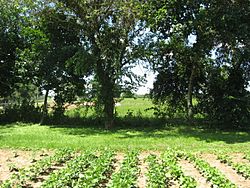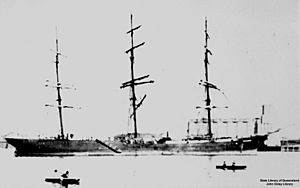Chalahgawtha facts for kids
Chalahgawtha (or, more often, Chillicothepronounced [{{{1}}}]) was the name of one of the five main groups, or divisions, of the Shawnee people. The Shawnee are a Native American tribe. This was during the 1700s.
Chillicothe was also the name of the main village for this division. The other four Shawnee divisions were the Mekoche, Kispoko, Pekowi, and Hathawekela. These five groups together formed the Shawnee tribe.
Contents
Understanding the Chillicothe Division
The Shawnee people had special traditions for each of their divisions. Each group had certain jobs or roles for the whole tribe. Over time, some of these customs changed.
The Chillicothe division often helped lead the entire Shawnee tribe. They were important in making decisions. A well-known leader from the Chillicothe division was Chief Blackfish.
Many Villages Named Chillicothe
The main village where the chief of the Chillicothe division lived was also called "Chillicothe." When this main village moved, often because of wars or new settlements by European Americans, the new village would still be called "Chillicothe."
Not all Shawnee people living in these towns belonged to the Chillicothe division. People from other tribes also lived there. Because of this way of naming towns, many historical records mention different "Chillicothe" villages. This can sometimes make it confusing for people studying history.
Chillicothe Villages on the Scioto River
One large Shawnee town was called Lower Shawnee Town by European American colonists. It was built around 1734 on the Ohio River. We don't know the Shawnee name for this town, but some experts think it might have been "Chillicothe."
This town became a major place for trading goods before the French and Indian War. Many Shawnee from different divisions lived there. Other Native Americans, Europeans, and even African Americans also lived in the town. It had about 1,200 people or more.
Lower Shawnee Town was left empty in 1758. The people moved north into central Ohio. They wanted to avoid attacks from the Virginia militia.
The next Chillicothe village (from 1758 to 1787) was one of seven Shawnee villages. It was on the west bank of the Scioto River, near Paint Creek. This area is now near the modern city of Chillicothe, Ohio.
This village was settled in the late 1750s. People from Lower Shawnee Town and Logstown moved there. This was when the Shawnee were returning to the Ohio Country. They had been forced out by the Iroquois many years before.
Cheeseekau, who was the older brother of Tecumseh, was likely born here around 1761. Tecumseh himself might have been born here in 1768. He might also have been born at a nearby Kispoko town. In 1762, this Chillicothe village had about 300 warriors. This meant about 1,200 people lived there. Most of the Shawnee in Ohio lived in this area at that time.
European goods like guns, kettles, and clothes were common among the Shawnee. A missionary named David Jones visited the town in 1773. He noted that a British fur trader lived there.
In the early 1770s, the Shawnee towns on the Scioto River became important. The Shawnee led a movement to stop colonists from moving onto their hunting grounds. This happened after the 1768 Treaty of Fort Stanwix. The Shawnee tried to form a big alliance with other tribes, but they were not successful.
They fought Dunmore's War in 1774 with little help from other tribes. An army from Virginia marched to the Scioto villages. They forced the Shawnee to accept the border set by the Stanwix treaty.
After the American Revolutionary War began, many Chillicothe residents moved northwest. They formed a new village on the Little Miami River. Some Shawnee and Cherokee people continued to live on the Scioto. But the village was attacked by Americans in 1787 during the Northwest Indian War.
Old Chillicothe: A Famous Village
Old Chillicothe (from 1774 to 1780) was the most famous Chillicothe village in American history. This is because it was very important during the American Revolutionary War. It is often called "Old Chillicothe" to tell it apart from the modern city of Chillicothe.
This village started in 1774. It was located on the Little Miami River. Today, this area is known as Oldtown, near Xenia.
Old Chillicothe was the home of Blackfish, who was a war chief. From here, the Shawnee often raided Kentucky. They hoped to make the American settlers leave. The famous frontiersman Daniel Boone was captured in Kentucky in 1778 by Chief Blackfish. Boone was brought to Chillicothe with other prisoners. He was adopted into the tribe and lived in Chillicothe for several months.
Some stories say that Tecumseh was born in this village. However, Tecumseh was born in 1768, before this Chillicothe village was settled. As mentioned earlier, he was likely born in a village on the Scioto River.
During the American Revolutionary War, there were raids on both sides of the Ohio River. Chief Blackfish attacked Boonesborough, Kentucky in 1778 but was not successful. After this, Americans crossed the Ohio River and attacked Chillicothe on May 29, 1779. Blackfish successfully defended the town. But he was shot in the leg and later died from the infection.
In 1780, George Rogers Clark led the Kentucky militia to the Little Miami River. This was to get back at the Shawnee for attacks in Kentucky. The Shawnee and others left Chillicothe as Clark came closer. Clark burned the town and destroyed the crops around it. Some say the Shawnee burned the town themselves before leaving. This was to prevent the Kentucky militia from taking their supplies. Clark then marched further north and fought a battle at Pekowi town. He defeated the Shawnee there.
Other Chillicothe Villages
After the destruction of Old Chillicothe, a new Chillicothe village was settled on the Great Miami River (from 1780 to 1782). Even though the British army surrendered in 1781, the fighting continued on the frontier. In Kentucky, American soldiers lost a big battle in August 1782.
In response, Clark led another trip into Ohio in November. This was the last major campaign of the war. His forces destroyed this Chillicothe village and four other villages.
Another Chillicothe village was on the St. Mary's River (from 1783 to 1790). Yet another Chillicothe (from 1788 to 1792) was located on the Maumee River, near what is now Fort Wayne, Indiana. There was also a Chillicothe (from 1787 onwards) on the west bank of the Mississippi River, north of what is now Cape Girardeau, Missouri.



